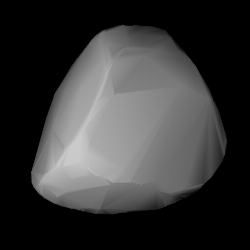astro.wikisort.org - Asteroid
626 Notburga is a large, dark asteroid orbiting the Sun in the asteroid belt.[1]
 Modelled shape of Notburga from its lightcurve | |
| Discovery | |
|---|---|
| Discovered by | August Kopff |
| Discovery site | Heidelberg |
| Discovery date | 11 February 1907 |
| Designations | |
MPC designation | (626) Notburga |
| Pronunciation | /nɒtˈbɜːrɡə/ |
Named after | Saint Notburga |
Alternative designations | 1907 XO |
| Orbital characteristics[1] | |
| Epoch 31 July 2016 (JD 2457600.5) | |
| Uncertainty parameter 0 | |
| Observation arc | 109.14 yr (39863 d) |
| Aphelion | 3.1985 AU (478.49 Gm) |
| Perihelion | 1.9481 AU (291.43 Gm) |
Semi-major axis | 2.5733 AU (384.96 Gm) |
| Eccentricity | 0.24295 |
Orbital period (sidereal) | 4.13 yr (1507.8 d) |
Mean anomaly | 277.12° |
Mean motion | 0° 14m 19.536s / day |
| Inclination | 25.371° |
Longitude of ascending node | 341.645° |
Argument of perihelion | 43.678° |
| Physical characteristics | |
Mean radius | 50.365±1 km[1] 48.42 ± 2.335 km[2] |
| Mass | (3.24 ± 1.30) × 1018 kg[2] |
Mean density | 6.81 ± 2.90 g/cm3[2] |
Synodic rotation period | 19.353 h (0.8064 d) |
Geometric albedo | 0.0437±0.002 |
Absolute magnitude (H) | 9.00 |
References
- "JPL Small-Body Database Browser: 626 Notburga(1907 XO)" (18 January 2013 last obs). Retrieved 7 May 2016.
- Carry, B. (December 2012), "Density of asteroids", Planetary and Space Science, vol. 73, pp. 98–118, arXiv:1203.4336, Bibcode:2012P&SS...73...98C, doi:10.1016/j.pss.2012.03.009. See Table 1.
External links
- 626 Notburga at AstDyS-2, Asteroids—Dynamic Site
- 626 Notburga at the JPL Small-Body Database
На других языках
[de] (626) Notburga
(626) Notburga ist ein Asteroid des Hauptgürtels, der am 11. Februar 1907 vom deutschen Astronomen August Kopff in Heidelberg entdeckt wurde.- [en] 626 Notburga
[es] (626) Notburga
(626) Notburga es un asteroide perteneciente al cinturón de asteroides descubierto el 11 de febrero de 1907 por August Kopff desde el observatorio de Heidelberg-Königstuhl, Alemania. Está nombrado en honor de Notburga de Hochhausen.[2][ru] (626) Нотбурга
(626) Нотбурга (нем. Notburga) — астероид главного пояса, который был открыт 11 февраля 1907 года немецким астрономом Августом Копффом в Гейдельбергской обсерватории и назван в честь Нотбурги Хоххаузенской (нем.) (рус., дочери короля франков Дагоберта I[2].Текст в блоке "Читать" взят с сайта "Википедия" и доступен по лицензии Creative Commons Attribution-ShareAlike; в отдельных случаях могут действовать дополнительные условия.
Другой контент может иметь иную лицензию. Перед использованием материалов сайта WikiSort.org внимательно изучите правила лицензирования конкретных элементов наполнения сайта.
Другой контент может иметь иную лицензию. Перед использованием материалов сайта WikiSort.org внимательно изучите правила лицензирования конкретных элементов наполнения сайта.
2019-2025
WikiSort.org - проект по пересортировке и дополнению контента Википедии
WikiSort.org - проект по пересортировке и дополнению контента Википедии